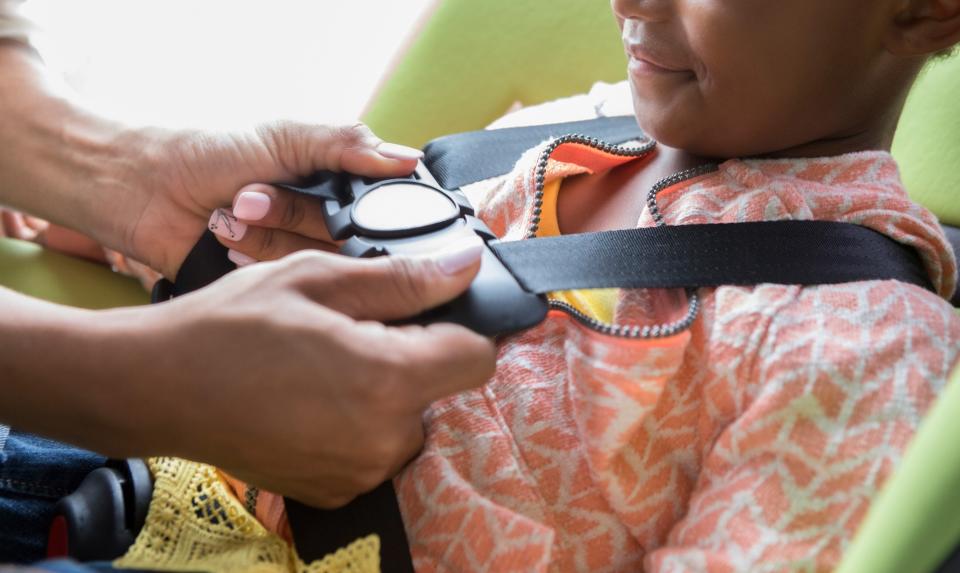Terrifying Evenflo Booster Seat Safety Concerns Remind Parents to Follow AAP Guidelines
When you buy a car seat, you assume it not only passes federal regulation, but also internal safety tests with flying colors. Right? Well, a new investigation from nonprofit news organization ProPublica suggests otherwise.
This month, ProPublica released a shocking investigative piece that suggests booster seat seller Evenflo ignored safety recommendations in the past, putting children who used its Big Kid booster seat at risk for injury or death.
The safety engineer of Evenflo expressed concerns in February 2012 about the Big Kid booster seat, saying it’s not suitable for children under 40 pounds. At the time, minimum weight recommendations were set at 30 pounds, and it was often marketed to babies as young as 1.
Side-impact safety tests revealed that catastrophic head, neck, spinal injuries—and even death—could occur in those under 40 pounds involved in a crash. These conclusions were made based on the movements of child-size crash dummies during testing.
Despite these findings, however, Evenflo continued to market the product to kids that weighed 30 pounds or more. Indeed, they claimed that the Big Kid booster seat “passed” side-impact tests they conducted.
How could they make this claim? The National Highway Traffic Safety Administration implemented safety rules for car seats and booster seats about 20 years ago, but there’s no standard of testing for side-impact tests, according to the ProPublica story. Manufacturers must only prove that their products pass head-on collision testing. So Evenflo continued putting "Side Impact Tested" on their product without any explanation of their results.
In light of the ProPublica discovery, the company stands by the safety of its products. Evenflo general counsel Amy Blankenship told ProPublica that the Big Kid booster seat complies with federal regulations, and there have been “hundreds of accidents" where children sitting in Big Kid boosters were unscathed or received minimal injuries. She also added that no booster can completely guarantee child safety during a crash, no matter if the kid weighs more or less than 40 pounds.
Even so, several consumers have sued Evenflo for injuries (internal decapitation and traumatic brain injury) involving young children. Blankenship blamed bad driving for these settled cases. No matter the real reason for these injuries, though, parents need to be aware of the claims against the Big Kid boosters—especially since Evenflo has sold 18 million of them.

SDI Productions/Getty Images
How Parents Can Protect Their Kids
Evenflo might’ve been lax about safety regulations in an effort to compete with other booster seat manufacturers. But that leads to another issue: ProPublica reports that “at least six other companies,” including Graco, produce booster seats claiming safety for children who weigh "as little as 30 pounds."
Before you worry, though, there are ways to reduce your child’s risk of injury in the car. A November 2018 report from the American Academy of Pediatrics (AAP) says children should use “rear-facing car safety seats as long as possible.” After they surpass the maximum height or weight limits for these rear-facing seats, they should use a forward-facing one through at least 4 years of age. Next up is a booster seat until at least age 8. Every person who has outgrown a booster seat should wear lap and shoulder seat belts, adds the AAP.
RELATED: Tips for Buying a Car Seat
You should also check the car seat’s label for maximum height and weight recommendations. Some forward-facing seats have a maximum weight of 65 pounds, for example, while others go up to 85 pounds, says a safety report from ProPublica.
Finally, make sure that your child is properly secured in the car seat. You’ll find instructions and diagrams on the ProPublica website here.
The bottom line: Always follow the AAP guidelines when it comes to buying a car seat, and don't skimp on safety when using it. You could save your child's life.

